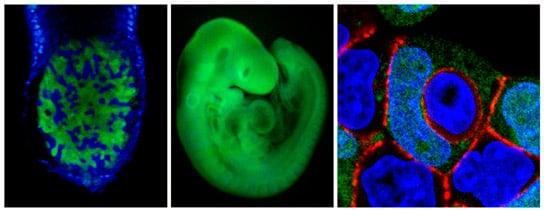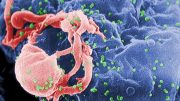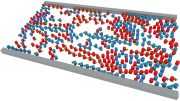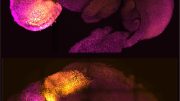
Left: An early mouse embryo in which the scientists generated a genetic mosaic of two cell populations, green and blue. Center: Three days later, the green cells, in which the levels of Myc protein have been artificially increased, have won the battle and eliminated the blue cells. Right: A cell with more Myc (green) engulfing one of its neighbors. Credit: Centro Nacional de Investigaciones Cardiovasculares (CNIC)
New research from the Centro Nacional de Investigaciones Cardiovasculares reveals that cells in the early embryo battle each other to death to become part of the organism.
Spanish researchers at the Centro Nacional de Investigaciones Cardiovasculares (CNIC) have found that during the early stages of mammalian development, embryonic cells embark on a battle for survival. Through this battle, the less active of these cells are eliminated by their stronger sisters. The work is published today in the prestigious journal Nature.
This phenomenon, termed cell competition, occurs in a defined time window, between days 3 and 7 of mouse development. During this period all embryonic cells compete with each other, as explained by Dr. Cristina Claveria, first author of the study, and Dr. Miguel Torres, director of this work and Head of the Department of Cardiovascular Development and Repair at CNIC.
“Thanks to cell competition the developing organism optimizes itself by selecting the cells theoretically more capable of supporting vital functions throughout the life of the new individual,” says Dr. Claveria. According to the authors, this would be particularly important in long-lived organisms, like humans, where the functionality of their tissues must be maintained throughout a long life.
Dr. Miguel Torres also explains that when cell competition is prevented, cells that normally would have lost the battle now become able to contribute to the new organism: “We think, however, that this organism will probably be less capable than the one which would have been formed under normal circumstances. In what sense will it be less adequate is a matter of great interest that we will address in the coming years”.
Indeed, the researchers are able to determine in advance which cells will win this battle: those with higher levels of the Myc protein, an important controller of cell metabolic capacity. Moreover, using a new technique that they have developed for the production of genetic mosaics, they are able to manipulate the levels of Myc protein in cells, thus changing the outcome of the fight.
According to Claveria and Torres, the study shows that the early embryo is a mosaic of cells with very different levels of Myc, in which cells with higher levels of Myc eliminate those with lower levels. However, it is important to understand that those who die are viable cells. “Their removal occurs only because the embryo has more suitable cells able to replace them, and therefore this is an optimization mechanism, not a repair one,” the researchers point out.
A fascinating aspect of the work is the illustration that this battle does not waste cellular resources; dying loser cells are engulfed and digested by their winning neighbors, who then recycle and use all the nutrients for the benefit of the embryo.
This research provides answers to some of the questions raised nearly forty years ago by Spanish scientists Ginés Morata and Pedro Ripoll, who in 1975 discovered cell competition in the fruit fly. On that occasion, by experimental manipulation, they described the phenomenon in the fly’s wing. Since then cell competition has been suggested to be involved in multiple processes, including tumor progression and tissue regeneration; but never, until this study, had a natural function been described.
Reference: “Myc-driven endogenous cell competition in the early mammalian embryo” by Cristina Clavería, Giovanna Giovinazzo, Rocío Sierra and Miguel Torres, 10 July 2013, Nature.
DOI: 10.1038/nature12389









This competition seems universal, now observed even in galaxies.
What will be the impact on the abortion debate if these results are confirmed in mammalian systems closer to Homo sapien? The successful embryo survives at the expense of cells that the authors tHINK may not survive as well in the long term. Are the experimenters going to pursue selecting a “weaker” embryo to see if indeed it is less viable?
This gives credence to the theory that cell organelles mitochondria, ribosomes and golgi apparatus and in plants platelets, and chlorophyl were once individual organisms that got fused with the more competing cells to form a stable structure in the theory of evolution for their survival. Thank You.